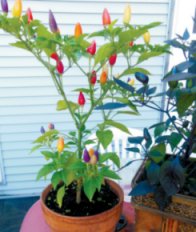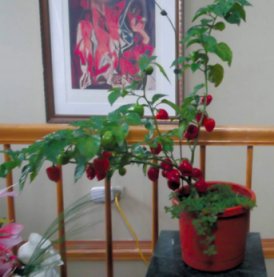By: Joe Mauricio
It was late March when I got a call from my friend, Fred Tsai, who just came back from his annual quadruple treks from the Philippines. After exchanging pleasantries, Fred had asked me if I had started planting “siling labuyo” and other pepper species in my deck garden.
My “pepper plantation” (in pots), as Veronica loves to call it, was started twelve years ago, with Fred as my guru. We love to give away these peppers to friends, and likewise use them as decors and eat them as spices to our foods. Great conversation items, too.
Through the years, my collection of peppers, with the help of the Pepper Institute of New Mexico grew to 51 species, from sweet to the hottest (Trinidad Scorpion with Scoville unit reading of 1.2 million), Our native labuyo pride has only a Scoville reading of only 300,.000, proving that it’s not the hottest as our friends from the Philippines claimed.
Since its discovery by Christopher Columbus in the Americas, chile pepper has become one of the most widely consumed spices in the world. Peppers derive their heat and healing properties from ingredient capsaicin, an alkaloid found mostly in their seeds and inner membranes. If you noticed, I spell chiles with an “e” rather than “i”. which in the United States is generally used in Tex-Mex blend of spices.
Fred’s famous hot pork dish (that we all die for) uses labuyo that are cut into small pieces exposing seeds and membranes for hotness. The recipe for his hot pork dish is still a guarded secret.
When cooking, I use the whole chile as we always want and need more in our typical VT household where everyone loves it hot. Mincing chiles release more capsaicin and make your dish spicier.
Now we have shown how chiles have conquered nations, therefore, we advise chile lovers to take pity on those skeptics who say the pungent pods as just a fad. Simply serve them some of the recipes contained in chile books and while they are sweating, tell them that if chiles are a fad, they have been so for about ten thoussand years,
P.S.: My chile seedlings are now two-inches high and growing fast, and should be ready for transplanting in late spring for the summer blooming.
Surely, looking forward to a hotter, peppery summer!

 My beautiful, colorful pepper plants decorate our living parlor.
My beautiful, colorful pepper plants decorate our living parlor.
 VIA Times – April 2015 Issue Vital News, Vibrant VIews for Asian Americans in Chicago & Midwest
VIA Times – April 2015 Issue Vital News, Vibrant VIews for Asian Americans in Chicago & Midwest




